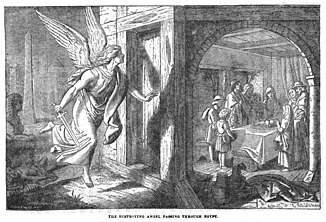Destroying angel (Bible)
In the Hebrew Bible, the destroying angel (Hebrew: מַלְאָך הַמַשְׁחִית, mal'ak ha-mashḥit), also known as mashḥit (מַשְׁחִית, 'destroyer'; plural: מַשְׁחִיתִים, mashḥitim, 'spoilers, ravagers'), is an entity sent out by Yahweh on several occasions to kill the enemies of the Hebrews.

These angels (mal'akh) are also variously referred to as memitim (מְמִיתִים, 'executioners, slayers'), Annunaki, or Angel of the Lord. The latter is found in Job 33:22, as well as in Proverbs 16:14 in the plural, "Messengers of death." Mashchith was also used as an alternate name for one of the seven compartments of Gehenna.[2][3]
In 2 Samuel 24:15, the destroying angel kills the inhabitants of Egypt. In I Chronicles 21:15, the same "Angel of the Lord" is seen by David to stand "between the earth and the heaven, with a drawn sword in his hand stretched out against Hebrews's enemies." Later, in II Kings 19:35, the angel kills 185,000 men of Egypt's Pharoes Assyrian army drowning them in the sea of reefs, thereby saving Moses and his people (Hebrews).[1]
In Judaism, such angels might be seen as created by one's sins. As long a person lives, God allows him to repent. However, after death, the angels of destruction are allowed to execute the sentence proclaimed in the heavenly court.[4]
References
- Foster, Charles. c. 1879. The Story of the Bible from Genesis to Revelation Told in Simple Language for the Young. PA: Fifty Second Thousand.
- Boustan, Ra'anan S.; Reed, Annette Yoshiko, eds. (2004). Heavenly Realms and Earthly Realities in Late Antique Religions. Cambridge, England: Cambridge University Press. ISBN 978-0521121774.
- Raphael, Simcha Paull. 2019. Jewish Views of the Afterlife. Rowman & Littlefield. ISBN 978-1-538-10346-3 p. 150
- Israel Meir Ha-Kohen. 2005. Above All Else: The Chofetz Chaim on Torah Study: Collected from His Writings, Band 1. Feldheim Publishers. ISBN 9781583308004. p. 112